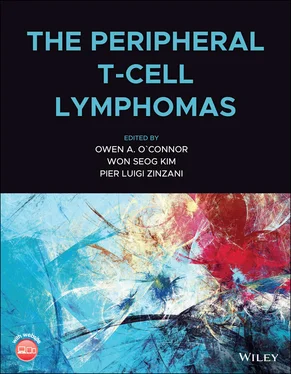Large granular lymphocytic leukemia (LGLL) constitutes around 6% of the chronic lymphoproliferative disorders in Asia and approximately 2–5% of the chronic lymphoproliferative disorders in the United States [54]. The incidence of LGLL is 0.2 cases per 1 000 000 individuals (range 0.17–0.23). The incidence among African Americans, American Indians/Alaska Natives or Asian/Pacific Islanders is not significantly different compared with White Americans [69]. LGLL is rare in children, and exhibits a median age of onset of 60 years [70]. There is no reported gender difference in incidence.
A distinctive feature of LGLL is its known association with autoimmune and hematological disorders. Rheumatoid arthritis is the most common autoimmune disorder which is known to be associated, occurring in approximately 25% of patients with LGLL [71]. It is also known to coexist with other myeloid and lymphoid malignancies, including monoclonal gammopathy of undetermined significance, follicular lymphoma, Hodgkin lymphoma, chronic lymphocytic leukemia, mantle cell lymphoma, and hairy cell leukemia [72, 73].
Primary Cutaneous Gamma/Delta PTCL
Primary cutaneous gamma–delta PTCL was originally classified under cutaneous panniculitis‐like T‐cell lymphoma [74], however, due to its gamma–delta phenotype and the aggressive nature of disease, it was recognized as a separate entity in the 2008 WHO classification [9, 75]. It accounts for approximately 1% of CTCLs and because of the rarity of this entity its exact incidence and specific risk factors are not well understood. While males and females are equally affected, the age of incidence ranges from 40 to 60 years [76]. Unlike other types of PTCL, the most common site of origin is oral mucosa, as gamma–delta T‐cells are more prevalent at mucosal sites [77].
Enteropathy Associated T‐cell Lymphomas and Monomorphic Epitheliotropic Intestinal T‐cell lymphoma
In combination, EATL and monomorphic epitheliotropic intestinal T‐cell lymphoma (MEITL) account for approximately 5% of all T/NK‐cell lymphomas [10, 51, 77]. In the past, EATL was classified into two subtypes. Type I is associated with celiac disease and type II is designated by lack of association with celiac disease. Both types originate from intraepithelial T cells of intestinal origin. The most recent 2017 WHO classification recognized type II EATL as a separate entity, now referred to as MEITL, based on its histologic characteristics [9]. EATL is primarily seen in individuals of northern European origin, where there is a higher incidence of celiac disease, whereas MEITL is a relatively aggressive type and is more frequently reported from Asia, but with apparent increase in frequency in individuals of Hispanic origin [78]. Individuals with celiac disease that is not adequately treated or is untreated have a higher incidence of developing EATL.
Hepatosplenic T‐cell Lymphoma
HSTL was initially called hepatosplenic gamma–delta T‐cell lymphoma, but with identification of the alpha/beta T‐cell receptor in the liver, sinusoids of spleen and bone marrow, it was subsequently reclassified as HSTL. It is a very rare neoplasm, which usually has an aggressive course and carries a poor prognosis. HSTL accounts for less than 1% of NHL [9]. Only a few cases are reported in the literature, so the exact incidence is unknown [79]. It appears to have a male predominance with a median age at diagnosis of approximately 35 years [80]. Approximately, 15–20% of patients diagnosed with HSTL are known to be on prolonged immune‐suppressive therapy in the setting of solid organ transplantation, and inflammatory bowel disease [81, 82].
The Cutaneous T‐cell Lymphomas
Mycosis fungoides is the most common subtype of CTCL, accounting for approximately 50% of all primary CTCLs [83]. Like other lymphomas, it exhibits a male predominance with a ratio of two to one [84]. It is a disease affecting mostly older white populations, with a median age at diagnosis of 55–60 years [85]. Hispanic and African Americans typically present at a younger age, with most patients diagnosed by 40 years [51, 86]. A personal history of alcohol and tobacco use [87] and occupations such as carpentry, painting, textile industry, and farming are known to be associated with higher incidence of mycosis fungoides [88].
Sézary syndrome was initially thought to be a leukemic form of mycosis fungoides, but with advancement in histopathologic and genetic technique, is now classified as a separate entity. While the exact incidence is unknown it is thought to accounts for about 2–5% of CTCLs [85]. The incidence of Sézary syndrome is most common in non‐hispanic white populations [89]. Male predominance is noted with a male to female ratio of 2.1 : 1 [90].
The T‐cell lymphomas are fairly unique among the NHLs, in that they do exhibit an interesting geographic variation in their distribution, In most cases, we do not yet understand the biological basis for most of this variability, though those cases associated with viruses, like HTLV1 ATLL, do track with the distribution of the infection. The rarity and heterogeneity of the disease demand global collaboration in order to better appreciate the biological factors that may predispose to this geographic variability.
Weisenburger, D.D., Savage, K.J., Harris, N.L., et al. (2011). Peripheral T‐cell lymphoma, not otherwise specified: a report of 340 cases from the international peripheral T‐cell lymphoma project. Blood 117: 3402.
Vose, J., Armitage, J., Weisenburger, D. (2008). International peripheral T‐cell and natural killer/T‐cell lymphoma study: pathology findings and clinical outcomes. J Clin Oncol 26 (25): 4124–4130.
de Leval, L., Parrens, M., Le Bras, F. et al. (2015). Angioimmunoblastic T‐cell lymphoma is the most common T‐cell lymphoma in two distinct French information data sets. Haematologica 100 (9): e361–e364.
Chihara, D., Ito, H., Matsuda, T., et al. (2014). Differences in incidence and trends of haematological malignancies in Japan and the United States. Br J Haematol 164: 536.
1 1 Alibert, J.L. (1806). Description des maladies de la peau observées a ‘hôpital Saint Louis et exposition des meilleures méthodes suivies pour leur traitement. Paris: Barrois L’Aine et Fils.
2 2 Sezary, A. and Bouvrain, Y. (1938). Erythrodermic avec presence de cellules monstrueuses dams le derme et le sang circulant. Bull Soc Fr Dermatol Syphiligr 45: 254–260.
3 3 Gerard‐Marchant, R., Hamlin, I., Lennert, K. et al. (1974). Classification of non‐Hodgkin lymphomas. Lancet 2: 406–408.
4 4 Whang‐Peng, J., Bunn, P.A. Jr., Knutsen, T. et al. (1982). Clinical implications of cytogenetic studies in cutaneous T‐cell lymphoma (CTCL). Cancer 50 (8): 1539–1553.
5 5 Pinkus, G.S., Said, J.W., and Hargreaves, H. (1979). Malignant lymphoma, T‐cell type A distinct morphologic variant with large multilobated nuclei, with a report of four cases. Am J Clin Pathol 72 (4): 540–550.
6 6 Harris, N.L., Jaffe, E.S., Stein, H. et al. (1994). A revised European‐American classification of lymphoid neoplasms: a proposal from the International Lymphoma Study Group. Blood 84 (5): 1361–1392.
7 7 Satou, A.N., Bennani, N., and Feldman, A.L (2019). Update on the classification of T‐cell lymphomas, Hodgkin lymphomas, and histiocytic/dendritic cell neoplasms. Expert Rev Hematol 12 (10): 833–843.
8 8 Non‐Hodgkin’s Lymphoma Classification Project (1997). A clinical evaluation of the International Lymphoma Study Group classification of non‐Hodgkin’s lymphoma. Blood 89: 3909–3918.
Читать дальше












